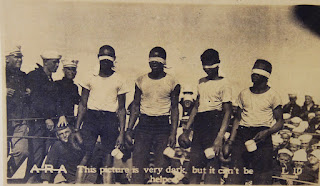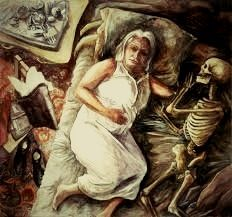The Dehumanization and Classification of African Americans in Ralph Ellison's "Battle Royal"
The Dehumanization and Classification of African Americans in Ralph Ellison's "Battle Royal"
In The Politics of Ellison's Booker: Invisible Man as Symbolic History, the author discusses the significance of Booker T. Washington's ideology in shaping early twentieth century African American identity and success. This ideology is reflected in the character of the young Negro in Voltaire's Candide, who embraces the prevailing notion of success for people of color in the South at the time, a notion influenced by Booker T. Washington's ideas.
The young black man's belief that the most successful blacks are those who prove themselves vital to white society is consistent with Washington's philosophy of gradualism and reconciliation with white society. This belief is evident in the narrator's desire to be like Booker T. Washington, who advocated vocational training and self-reliance as a path to success for African Americans (Kostelanetz,6).
Within this historical context, in Battle Royal in Ralph Ellison's Invisible Man, the young black man's desire to succeed by conforming to the expectations of white society reflects his struggle with his own identity and society's expectations of him as a black man.
In Ellison's Bookerian Politics: The Invisible Man as Symbolic History, it is noted that Booker T. Washington argued that if blacks were to succeed, they could not challenge the system of white supremacy, but rather had to advocate for "responsibility" rather than "equality". Washington feared that demands for equal rights would only destabilize the South; not only would riots have little chance of success, but the cost in black lives would be too high to be worth it. He wrote that "the wisest men of my race understand the extreme folly of agitation on the question of social equality" because blacks, like Washington himself, must be "modest in their political claims." He asserts that political rights "will be granted to the Negro by the people of the South themselves, and will protect the Negro in the exercise of those rights," and that they will be granted only when the Negro takes the path of humility and impresses white society with his seriousness and contribution to its material prosperity. In Fighting Royals, the protagonist attempts to gain recognition and success in white society by presenting himself in a humiliating contest, similar to Washington's advocacy of winning over white society through humility and hard work. The protagonist is taught to conform to the white-centered social system and not to challenge authority or seek equality, but to succeed through self-sacrifice and hard work. In the punch, it can be seen that Washington's advocacy influences the protagonist's behavior and attitudes to try to conform to the expectations of the white society, which reflects the concept of Washington's ideas for African Americans to succeed in the society of the time (Kostelanetz, 7).
In Ellison's Booker's Politics: The Invisible Man as Symbolic History, a detailed analysis of the labor dynamics of the Freedom Painting Company in The Invisible Man emphasizes the exploitation of African American workers and the complexity of power dynamics within the industrial system, which mirrors, in Battle Royal, the challenges faced by African Americans in a society dominated by white authority. In the Battle Royal scene, the black man is forced to participate in a degrading act of violence for the entertainment of the white elite, symbolizing the systemic racism and oppression that African Americans face. His subsequent experience at the Freedom Paint Company further illustrates the economic exploitation and manipulation of African American labor by white-controlled industries. The hiring of the narrator as a "scab" in place of unionized white workers reflects the company's disregard for labor rights and its willingness to exploit racial divisions to maintain control and maximize profits. How the story of "The Invisible Man" became a symbolic history of African American resistance to systemic oppression and exploitation was shaped by the pervasive inequalities of racial segregation, discrimination, and economic disparities that characterized the African American experience in the early to mid-twentieth century.
In Battle Royal, Ralph Ellison depicts the manipulation and exploitation of African Americans by those in power, highlighting the challenges blacks face in asserting their rights and surviving in a society that systematically marginalizes them. This theme is further developed in the rest of Ellison's novel Invisible Man, in which he explores the means by which influential members of the African American community take advantage of other blacks and refuse to unite to fight the common threat of white racists.
A notable example of this theme is in the episode where Tatlock hesitates to orchestrate a defeat, which shows how some African Americans perpetuate their own oppression by not standing together in solidarity. The lack of unity among blacks allows those in power to maintain control over them and use them for personal gain.
In addition, Ellison elaborates on the concept of Social Darwinism in Battle Royal, in which warriors fight brutally for prizes. This reflects the notion that in a society dominated by racism and discrimination, individuals are forced to compete with each other for limited opportunities, perpetuating a cycle of exploitation and inequality. Furthermore, the negative impact of rewards on the protagonist in Battle Royal exemplifies how material incentives can be used to manipulate and divide African Americans, undermining their collective struggle for equality and justice. This theme highlights the insidious ways in which power dynamics and systemic oppression impact individuals in marginalized communities. Finally, Ellison explores the need for white people to support the symbolic features of their institutions to demonstrate their superiority over black people. This theme highlights how white supremacy is maintained through institutional and social norms, which further exacerbates the marginalization of African Americans.
All of this, embodied in Battle Royal, gives us a deeper understanding of the complexity of race relations and power dynamics in American society within the historical context of the African American struggle for equality and justice, and a glimpse of the challenges African Americans face and the ways in which they are manipulated and exploited by those in power.
The use of animal imagery in Ralph Ellison's Battle Royal also highlights the dehumanization and objectification of African Americans by white society, especially in the historical context of African Americans' struggle for equality and justice.
As Norman German points out in his analysis of the story, the lion symbolizes the white man who exerts power and dominance over African Americans. This is evident in the scene where the Invisible Man's grandfather advises his father to live with his head "in the lion's mouth," suggesting that African Americans must submit to the authority of white society. The people roaring as the Invisible Man struggles for coins on the electric carpet reflects the dehumanizing landscape of violence and exploitation that African Americans suffered during the Jim Crow era. Additionally, the dehumanization of African Americans is further emphasized by the laughter and roaring of white people in response to the invisible man's attempts to assert his agency and dignity. When the white man "laughs" and kicks the Invisible Man in the chest, it symbolizes the physical and mental violence that white society inflicts on African Americans (German, 394).
By placing these animal images and dehumanizing behaviors in Battle Royal, it exposes the ways in which African Americans are viewed as objects or animals by white society, leading to their dehumanization and marginalization. Through the lens of African American theory, we can further interpret Battle Royal as a critique of the power dynamics and hierarchies that perpetuate racial inequality and injustice. The story is a poignant reminder of the ongoing struggle African Americans face in their quest for liberation and equality in a society that seeks to dehumanize and oppress them.
In conclusion, Ralph Ellison's Battle Royal shows the impact of racism and discrimination on marginalized communities by depicting the manipulation, exploitation, and dehumanization that African Americans face in a society dominated by white authority. Not only does the story reflect Washington's advocacy, emphasizing the importance of humility and hard work to earn acceptance in white society, but it also explores how white supremacy asserts its power through institutions and social norms. Most importantly, through the use of animal imagery, Ellison reveals the ways in which white society views African Americans as objects or animals, exacerbating their marginalization and dehumanization. This theme deeply reflects the reality of racial inequality and injustice and calls us to reflect on and work to change this unjust status quo. Therefore, we should work together to eliminate racial discrimination and inequality through solidarity and efforts, and strive for a just and equal society.
Works Cited
German, Norman. “IMAGERY IN THE ‘BATTLE ROYAL’ CHAPTER OF RALPH ELLISON’S ‘INVISIBLE MAN.’” CLA Journal, vol. 31, no. 4, 1988, pp. 394–99. JSTOR, http://www.jstor.org/stable/44321997. Accessed 20 Mar. 2024.
“Racism in Ralph Ellison’s ‘Battle Royal’ - 1439 Words: Research Paper Example.” IvyPanda, ivypanda.com/essays/racism-in-ralph-ellisons-battle-royal/. Accessed 20 Mar. 2024.
Kostelanetz, Richard. “The politics of Ellison’s booker: ‘Invisible man’ as symbolic history.” Chicago Review, vol. 19, no. 2, 1967, p. 5, https://doi.org/10.2307/25294090.





I enjoyed reading your connection between the text and Booker T. Washington throughout the blog post. I also found it interesting to read about the animal imagery that is present in the short story and how it perpetuated the dehumanization of African Americans in the story. I hadn't really picked up on that running theme in the story, but it makes a lot of sense when you break it down.
ReplyDelete